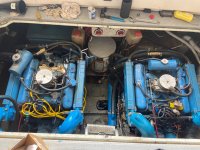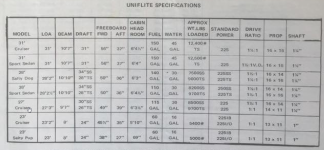Hello all
I've been going through the forum about the old Uniflites with Chrysler 318's. It seems that quite a few of you cruise in the high 20's, someone even said he was getting up to 40 mph.
I bought my boat 2 years ago. One engine overheated and stalled on the way to my new slip. For that entire summer I couldn't bring it over 2000 RPM without it overheating. Through trial and error I replaced the raw water pump, fresh water pump, manifolds, risers, cleaned heat exchanger, new carb and fuel pump.
Last summer there were no overheating issues. That said, the previous owner kept a fairly comprehensive journal. When they bought the boat 20 years ago they claimed that it would do about 22 knots at 3300 RPM. At that RPM I am lucky to get 17 knots. I usually try to cruise at 2700 RPM and I get about 14 knots.
I have fuel flow meters, working trim tabs, and my speed I am getting from my GPS.
Does this sound normal? Others seem to be getting a lot more speed from the same boat. Could the engines just be getting worn out? Should I check the compression? It has an updated point system, it seems like everything is working as it should, just real slow.
Thanks
I've been going through the forum about the old Uniflites with Chrysler 318's. It seems that quite a few of you cruise in the high 20's, someone even said he was getting up to 40 mph.
I bought my boat 2 years ago. One engine overheated and stalled on the way to my new slip. For that entire summer I couldn't bring it over 2000 RPM without it overheating. Through trial and error I replaced the raw water pump, fresh water pump, manifolds, risers, cleaned heat exchanger, new carb and fuel pump.
Last summer there were no overheating issues. That said, the previous owner kept a fairly comprehensive journal. When they bought the boat 20 years ago they claimed that it would do about 22 knots at 3300 RPM. At that RPM I am lucky to get 17 knots. I usually try to cruise at 2700 RPM and I get about 14 knots.
I have fuel flow meters, working trim tabs, and my speed I am getting from my GPS.
Does this sound normal? Others seem to be getting a lot more speed from the same boat. Could the engines just be getting worn out? Should I check the compression? It has an updated point system, it seems like everything is working as it should, just real slow.
Thanks





